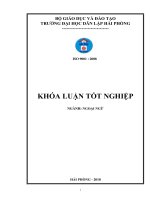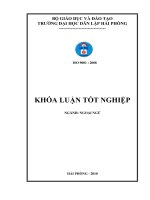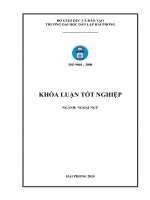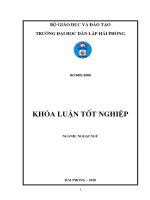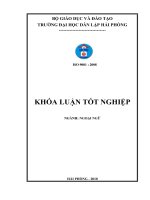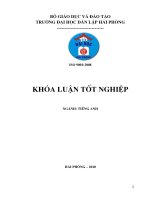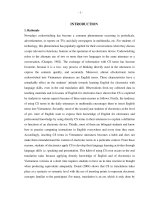A STUDY ON ENGLISH READING STRATEGIES USED BY THIRD YEAR ENGLISH MAJORS OF THAI AND MUONG ETHNIC MINORITIES AT TAY BAC UNIVERSITY
Bạn đang xem bản rút gọn của tài liệu. Xem và tải ngay bản đầy đủ của tài liệu tại đây (546.76 KB, 94 trang )
DECLARATION
This paper is submitted in partial fulfillment of the requirements for the degree of Master
of Education. I confirm that this is my own research, and that it has not been published or
submitted for any other degrees.
Student’s signature
ACKNOWLEGEMENTS
I would like to acknowledge the contributions of the following people, without those help
and guidance, this thesis would not have been completed.
First and foremost, I counted myself very fortunate to have had Nguyen Thai Ha, MEd as
my supervisor, and I would like to thank for her patience, corrections, advice and
encouragement.
Secondly, a special acknowledgement must go to Le Van Canh, MA who suggested the
appreciated ideas for this study.
Thirdly, I must also express my most sincere appreciation to my colleagues who have
helped to gather data, who have had assisted with data analysis, and who have helped by
reading and giving useful advice. Especially, I would like to acknowledge the assistance
given by Mrs Do Thi Thanh Tra, who has always been a well- wishing friend.
Fourthly, I am grateful to the students who participated in this study by answering the
questionnaires and doing think-aloud reports and contributed considerably to its success.
Lastly, my heartfelt gratitude goes to my loving parents, my siblings, and my husband who
have supported me with their patience, encouragement.
ABSTRACT
This thesis begins with the premise that learning strategies have been widely
accepted as the keys that lead to success in learning a language. A lot of research has been
carried out in various contexts to investigate the use of language learning strategies by
different learners and the effects of such factors as gender, motivation, age, and so forth on
the use of language learning strategies. Reading comprehension strategies have been
identified by various researchers in both second and foreign language contexts. However,
little empirical research has been conducted to uncover the reading comprehension
strategies used by Vietnamese students, especially by students at Tay bac Unuversity
(TBU). To address this gap, the present study investigates reading comprehension
strategies used by third-year English majors of Thai and Muong ethnic minorities at TBU.
The present study investigated the use of reading learning strategies of 12 third year
English major students of Thai and Muong minorities at TBU and the possible influence on
their choice of strategies by their ethnicity. The use of strategies by Muong and Thai
ethnic students at TTBU were assessed and measured by think-aloud reports. The gathered
data was analyzed with the help of t-test. The most frequently used strategies were reported
were metacognitive, followed by cognitive and social/affective. Besides, Thai and Muong
ethnic showed that they were significantly different in the choice and frequency of strategy
use. Muong students had more preference for the use of metacognitive and cognitive
strategies, whereas Thai used social/ affective strategies more frequently than their Muong
ethnic counterparts. These results of the study indicated that ethnicity is a factor that had
influence on the use of strategies as the findings of the previous research. Based on the
findings some discussion and implications were made along with suggestions for further
research.
LIST OF CONTENTS
ABSTRACT III
LIST OF CONTENTS IV
LIST OF FIGURES VIII
CHAPTER 1: INTRODUCTION 1
1.1 Introduction 1
1.2 Rationale 1
1.3 Aims of the study 2
1.4 Scope of the study 3
1.5 Significance of the study 3
1.6 Design of the thesis 3
CHAPTER 2: LITERATURE REVIEW 5
2.1 Introduction 5
2.2 Language learning strategies 5
2.2.1 Definition 5
2.2.2 Classification of learning strategies 6
2.2.3 Factors affecting the learners’ learning strategy choice 12
2.3 The theory of reading 12
2.3.1 Definition of reading 12
2.3.2 Reading processes 14
2.3.3 Reading strategies 16
2.4 Previous studies on language learning strategies 17
2.4.1 Language learning strategies studies 17
2.4.2 Reading strategies studies 21
2.5 Summary 27
CHAPTER 3: METHODOLOGY 28
3.1 Introduction 28
3.2 Research questions 28
3.3 Participants and settings of the study 28
3.3.1 Participants 28
3.3.2 Settings of the study 29
3.4 Instruments 29
3.4.1 Questionnaires 30
3.4.2 Think-aloud reports 30
3.5 Pilot – study 30
3.5.1 Stage 1 31
3.5.2 Stage 2 31
3.5.3 Results of the pilot-study 31
3.6 Data collection procedures 31
3.6.1 Administering the questionnaires 31
3.6.2 Administering the think-aloud reports 32
Coding of data 32
3.7.1 Coding of questionnaire data 32
3.7.2 Think-aloud report data 32
3.8 Data analysis procedures 34
3.8.1 Questionnaire data 35
3.8.2 Think-aloud report data 35
3.9 Summary 35
CHAPTER 4: RESULTS 36
4.1 Introduction 36
4.2. Results of Questionnaires 36
4.2.1 Readers’ attitude to reading comprehension 36
4.3 Results of think- aloud reports 39
4.3.1 Students’ use of reading comprehension strategies 39
4.3.2 Difference in strategy use between Muong and Thai ethnic minorities 43
4.4 Summary 48
CHAPTER 5: DISCUSSION AND IMPLICATIONS 49
5.1 Introduction 49
5.2 Discussion 49
5.2.1 Muong and Thai ethnic minorities’ attitude to reading comprehension. 49
5.2.2 Strategy frequency 50
5.2.3 Difference in strategy use between Muong and Thai ethnic minorities 51
5.3. Reading strategies that Muong and Thai ethnic students need to develop 54
5.3.1 Reading strategies that Muong ethnic students need to develop 54
5.3.2 Reading strategies that Thai ethnic students need to develop 55
5.4 Implications 56
5.5 Limitations and further research 59
5.6 Conclusion 60
REFERENCES 62
APPENDIX 1: OXFORD’S STRATEGY CLASSIFICATION SYSTEM I
APPENDIX 2: QUESTIONNAIRES V
APPENDIX 3: READING TASK FOR THINK- ALOUD REPORT VII
APPENDIX 4: SAMPLE PROTOCOLS XII
APPENDIX 5: A SAMPLE OF THE CODED PROTOCOLS XIII
APPENDIX 6: RESULTS OF SAMPLE PROTOCOLS XV
APPENDIX 7:RAW DATA XVII
LIST OF ABBREVIATIONS
L1: The first language
L2: The second language
LLS: Language learning strategy
Sm: Muong ethnic student
RS: Reading strategy
St: Thai ethnic student
TBU: Tay Bac University
TOEFL: Teach of English as a foreign language
LIST OF TABLES
Table 1: The background information about the participants 29
Table 2: Coding scheme for the use of reading comprehension strategies 33
Table 3: Thai and Muong ethnic students’ preference to reading comprehension 36
Table 4: The role of reading comprehension to Muong and Thai ethnic students’ learning
English 37
Table 5: Factor affecting reading comprehension 38
Table 6: Strategy categories used by Muong and Thai Ethnic readers 43
Table 7: Difference in the use of individual strategies between Muong and Thai Ethnic
readers 43
Table 8: Reading strategies that Muong ethnic students need to develop 54
Table 9: Reading strategies that Thai ethnic students need to develop 55
LIST OF FIGURES
Figure 1: Reading comprehension strategy category frequency for Thai and 40
Figure 2: Individual strategy frequency within Metacognitive category for Thai and Muong
ethnic students 41
Figure 3: Individual strategy frequency within Cognitive category for Thai and Muong
Ethnic Students 41
Figure 4: Individual strategy frequency within Social/Affective category for Thai and
Muong Ethnic Students 42
Figure 5: CALLA Instructional Framework 58
CHAPTER 1: INTRODUCTION
1.1 Introduction
This chapter introduces the rationale and the aims of the study. The scope of the
study and the significance as well as the design of the thesis will also be presented in this
chapter.
1.2 Rationale
Reading is considered one of the most important skills which language learners
should master, particularly as it helps to build a variety of language expression and
structures, widen general knowledge and leads to lifelong learning and improvement in the
first and second language skills. “Reading is an essential skill for English as a
second/foreign language (SL/EFL) student; and for many, reading is the most important
skill to master” (Anderson, 1999). Carrell states (1989) “For many students, reading is by
far the most important of four skills in a second language, particularly in a language as a
second or foreign language”. This is true for Vietnamese learners who have studied
English through reading since English is taught and learned as a foreign language and in
non- native environment. But acquiring and mastering this skill is likely to become a big
hindrance to many learners while they often find it difficult to exploit this skill in their
learning experience. On the other hand, the findings of many ESL/EFL research projects
have shown the positive effects of learning strategies to enhance the comprehensibility of
learners or to overcome comprehension failures. “The employment of appropriate language
learning strategies can result in improved proficiency and greater self-confident.” (Oxford,
1990).
The current explosion of research in second language reading has begun to focus on
readers’ strategies. These strategies consist of whole range of strategies including
skimming, scanning, reading for meaning, guessing meaning of unknown words,
recognizing text structures and so forth. Most of the reading strategies research focus on
the investigation into reading strategies employed by successful and unsuccessful learners.
Less attention was given to the relationship between strategy use and such factors as
gender, age, motivation, and ethnicity. There is a need, therefore, to exam how these
factors affect on the use and the choice of reading strategies.
Since the early seventies, most research on reading strategies concerned about
teaching second language students to use a variety of language strategies to assist them
with the acquisition, storage, and retrieve of information in order to read better. This seems
to suggest that training students to use reading strategies means training them to become
autonomous readers. Therefore, it is necessary for teachers to raise learners’ awareness of
strategy use.
In reality, in reading lessons for English majors at TBU, more was done to link
reading comprehension and student background knowledge in order to equip them with
strategic learning method. However, these students still find reading is the most
challenging skill, and they complain that they do not know how to get the right answers of
the reading tasks, how to find the information in the reading texts effectively and so forth.
To be their teacher who is interested in teaching the reading skill, I really want to help
them to overcome these obstacles and improve their reading comprehension capacity.
For all of these reasons, I would like to carry out this study to investigate reading
strategies used by third-year English majors identified as Muong and Thai ethnic learners
in terms of the frequency of strategy use and strategy choice.
It is expected that the findings of this study will be helpful for researcher and other
teachers in some ways to exploit appropriate techniques to train students the use of reading
strategies and raise students’ awareness of employing suitable reading strategies.
1.3 Aims of the study
The study focus on investigating the reading strategies employed by third-year English
majors at TBU. Particularly, it examines the effects of ethnicity on the frequency of
strategy use and the choice of reading strategies. Thus, others factors that influence on
reading strategies and LLS in other skills would be beyond the scope of this paper.
1.4 Scope of the study
The study was conducted on the third- year students of Thai and Muong ethnic
minorities of English department at TBU only. These students’ reading strategy use was
investigated. This means the study was not intended to investigate the strategies in other
skills such as speaking, listening, or writing.
1.5 Significance of the study
This study is significant for several reasons. Firstly, it expands the limited research into
RSs with the emphasis on ethnicity for Vietnamese learners, particularly for students at
TBU. Secondly, the identification of reading comprehension strategies contributes to an
understanding of how readers actively attempt to comprehend the texts. Finally, the study
will have many important implications for training third-year students of English at TBU
in RS use.
1.6 Design of the thesis
The thesis is divided into five chapters as follow:
Chapter 1, Introduction, presents an overview of the study in which the rational for the
research, the aims and the scope of the research were briefly presented .The significance of
the study was also discussed.
Chapter 2, Literature Review, reviews the theoretical basis which underpins the study. This
chapter contains four sections: language learning strategies in terms of definitions and
taxonomies of LLSs, reading comprehension strategies including definitions, reading
comprehension processes and reading comprehension strategies, factors affecting RSs
choice and previous studies on language learning strategies.
Chapter 3, Methodology, is a detailed discussion of the method used to gather and analyze
data in this study. First, research questions are addressed. Then, instruments for data
collection, subjects, and procedures are described. The chapter ends with data analyzing.
Chapter 4, Results, presents significant findings of the study.
Chapter 5, Discussion and Implications, discusses major findings, provides implications,
recommends, and directions for future research and makes a final conclusion.
1.7 Summary
This chapter has presented an overview of the study which includes the rational for the
study, the aims, the scope, the significance as well as the design of the study. The next
chapter will review the relevant literature which provides a theoretical framework for the
study.
CHAPTER 2: LITERATURE REVIEW
2.1 Introduction
This chapter provides a brief review of the theory and research into language learning
strategies in general and reading learning strategies in particular including the researchers’
findings relating to definitions of learning strategies and reading, reading strategies,
previous studies on language and reading learning strategies, their taxonomies, data
collection methods and the factors affecting learners’ choice of reading learning strategies.
A justification on the basis of the literature review for the learning strategies definitions
and framework adopted by the researcher of the present study are also presented.
2.2 Language learning strategies
2.2.1 Definition
In the last two decades, there have been numerous studies of learning strategies used by
language learners by such well-known researchers as Tarone (1981), Oxford (1990),
Richard and Plat (1992), Cohen (1998). According to Tarone (1981), a learning strategy is
“an attempt to develop linguistic and sociolinguistic competence in the target language to
incorporate these into one’s interlanguage competence”. Clause & Casper (1983) defined
language learning strategies as learners’ trial to achieve linguistic and sociolinguistic
competence in the target language. These definitions are too narrow when they only focus
on the linguistic and sociolinguistic competence without mentioning to other aspects of
language learning such as cultural understanding.
Learning strategies in MacIntyre’s (1994) study are defined as “the actions chosen by
language students that are intended to facilitate language acquisition and communication”,
or learning strategies are “ intentional behaviors and thoughts used by learners during
learning so as to better help them understand, learn, or remember new information”
(Richards & Platt, 1992: 209). It can be seen that these researchers emphasized the
learners’ awareness and intention of using language strategies.
As clearly shown in O’Malley and Chamot’s definition (1990), language learning
strategies are “the special thoughts or behaviors that individuals use to help them
comprehend, learn, or retain new information”. In this definition, language learning
strategies can be either observable or unobservable (mental and behavioral), and language
learning strategies are individually characterized.
Oxford’s definition (1990) is often considered as the most comprehensive and widely
accepted for its full conveyance of affective aspects of language learning strategies by
saying “language learning strategies are specific actions taken by the learners to make
learning easier, faster, more enjoyable, more self-directed, more effective, and more
transferable to new situations”.
Given the fact that there is hardly any definition that can work in all contexts, a
working definition of language learning strategies for this study is needed. Considering
various definitions offered previously and the context of the study, the present research
based on definition of language learning strategies by O’Malley& Chamot (1990) and
Oxford (1990) as the key directions to its investigation.
2.2.2 Classification of learning strategies
Research into what learners do to learn a language has resulted in identification of
specific strategies and in attempt to classify them in some ways. Language learning
strategies have been classified in different systems, such as Bialystok (1987), Rubin
(1981), Wenden (1985), Naiman et al (1987), Oxford (1990), O’Malley& Chamot (1990).
In Bialystok’s model (1978), there are four types of strategies: (1) functional
practicing, (2) formal practicing, (3) monitoring, and (4) inferencing. The first strategy
used for functional purposes, such as completing a transaction at a store. Formal and
monitoring involve in strategies that utilized for language practice in the classroom. And
guessing meaning from context refers to the last strategy, inferencing. Obviously, the
emphasis of this model is on the cognitive and metacognitive aspects of learning. An
alternative classification scheme proposed by Naiman et al (1978) consists of five major
categories of learning strategies and a number of secondary categories. The five-primary
classification contains an active task approach, realization of language as a means of
communication and interaction, management of affective demand and monitoring second
language performance.
Rubin (1981) identified two kinds of learning strategies: those which contribute
directly to learning and those which contribute indirectly to learning. In direct learning
strategies, she divided into six types (classification/ verification, monitoring,
memorization, guessing/ inductive inferencing, deductive reasoning and practice), and
indirect learning strategies are divided into two types (creating opportunities for practice
and production tricks). Similarly to the model of Bialystok (1978), the limitation in
Rubin’s taxonomy is that it does not contain social and affective strategies.
Further step in language learning strategy classification has been made by Wenden
(1985) who conducted a research with adult foreign language learners to examine their
language learning strategies. Data analysis led to their classification of learning strategies
with three types: (1) Knowing about the language (relating to what language and learning
involves), (2) planning (relating to what and how of language learning), and (3) self-
evaluation (relating to progress in learning to the learners’ response to the learning
experience).
The more comprehensive and widely accepted framework is the classification systems
of O’Malley & Chamot (1990) and Oxford (1990). The strategy system proposed by
Oxford (1990) consists of both direct and indirect strategie (See appendix I). Direct
strategies required mental processing of the target language. Indirect strategies, on the
other hand, support and manage language learning often without involving the target
language directly.
Direct strategies are classified into:
• Memory strategies (9 items) are used for entering new information into memory
storage and for retrieving it when need for communication. (e.g., grouping,
representing sounds in memory, structured reviewing, using physical response).
• Cognitive strategies (14 items) are used for linking new information with existing
schemata and for analyzing and classifying it. Cognitive strategies are responsible
for deep processing, forming and revising internal mental models and receiving and
producing messages in the target language (e.g., repeating, getting the idea quickly,
analyzing and taking notes).
• Compensation strategies (6 items) include such strategies as guessing and using
gestures. Such strategies are needed to fill any gaps in the knowledge of the
language. (e.g., switching to the mother tongue, using other clues, getting help and
using a synonym).
On the other hand, indirect strategies are divided into Metacognitive, Affective and
Social:
• Metacognitive strategies (9 items) are techniques used for organizing, planing,
focusing and evaluating one's own learning. (e.g., linking new information with
already known one, seeking practice opportunities, and self-monitoring).
• Affective strategies (6 items) are used for handling feelings, attitudes and
motivations. (e.g., lowering anxiety by use of music, encouraging oneself and
discussing feelings with others).
• Social strategies (6 items) are used for facilitating interaction by asking questions,
and cooperating with others in the learning process, (eg. Asking for classification,
cooperating with others and developing cultural understanding).
In comparison with other classification schemes above, Oxford’s “perhaps the most
comprehensive classification of learning strategies to date” (Ellis, 1994, p. 539), and it is
more systematic since “it links individual strategies, as well as strategy groups, with each
of the four language skills” (Vidal, 2002, p. 47). Affective and social strategies are also
discussed in greater details. However, it is fairly confusing when memory strategies are
separated from cognitive ones.
In O’Malley & Chammot’s (1990) framework, strategies are divided into three major
types: metacognitive, cognitive, and social (affective. Metacognitive strategies are “higher
order executive skills that may entail planning for, monitoring or evaluating the success of
a learning activity” (O’Malley & Chamot, 1990, 44). Cognitive strategies “operate directly
on incoming information, manipulating in ways that enhance learning” (O’Malley &
Chamot, 1990, p.44). Social or affective strategies “involve either interaction with another
person or ideational control over affect” (O’Malley & Chamot, 1990, p.45). These
strategies were presented in table 1.
Table 1. Learning strategy definication and classification (O’Malley and Chamot
,1990, pp.119-120)
- M Metacognitive strategies involve thinking about the learning process, planning for
learning, monitoring the learning task, and evaluating how well one has learned.
Advance organizers
Previewing the main ideas and concepts of the material to be
learned, often by skimming the text for the organizing principle.
Directed attention Deciding in advance to attend in general to a learning task and to
ignore irrelevant distracters.
Functional planning Planning for and rehearsing linguistic components necessary to
carry out an upcoming language tasks.
Selective attention Deciding in advance to attend to specific aspects of input, often
by scanning for key words, concepts, and/or linguistic marker.
Self-management Understanding the conditions that help one successfully
accomplish language tasks and arranging for the presence of
those conditions.
Self-monitoring
Checking one's comprehension during listening or reading or
checking the accuracy and/or appropriateness of one’s oral or
written production while it is taking place.
Self-evaluation
Checking the outcomes of one's own language performance
against a standard after it has been completed.
Cognitive strategies involve interacting with the material to be learned, manipulating the
material mentally or physically, or applying a specific technique to a learning task.
Resourcing
Using target language reference materials such as dictionaries,
encyclopedias, or textbooks.
Repetition
Imitating a language model, including overt practice and silent
rehearsal.
Grouping
Classifying words, terminology, or concepts according to their
attributes or meaning
Deduction
Applying rules to understand or produce the second language or
making up rules based on language analysis.
Imagery Using visual images (either mental or actual) to understand or
remember new information.
Auditory
representation
Planning back in one’s mind the sound of a word, phrase, or
longer language sequence.
Keyword method
Remembering a new word in the second language by: (1)
identifying a familiar word in the first language that sounds like
or otherwise resembles the new word, and (2) generating easily
recalled images of some relationship with the first language
homonym and the new word n the second language.
Elaboration relating new information to prior knowledge, relating different
parts of new information to each other, or making meaningful
personal associations with the new information.
Transfer
:Using previous linguistic knowledge or prior skills to assist
comprehension or production.
Inferencing using available information to guess meanings of new items,
predict outcomes, or fill in missing information.
Note taking Writing down keywords or concepts in abbreviated verbal,
graphic, or numerical form while listening or reading
Summarizing Making a mental, oral, or written summary of new information
gain through listening or writing.
Recombination Constructing a meaningful sentence or larger language sequence
by combining known element in a new way.
Translation Using the first language as a base for understanding and/or
producing the second language.
Social and affective strategies involve interacting with another person to assist learning or
using affective control to assist a learning task.
Questioning for
clarification
Eliciting from a teacher or peer additional explanations,
rephrasing, examples, or verification.
Cooperation
: Working together with one or more peers to solve a problem,
pool information, check a learning task, model a language
activity, or get feedback on oral or written performance.
The brief overview of language learning strategies classification above shows that all
of these researchers made strenuous efforts in describing, interpreting, and classifying
various strategies. However, according to Goh & Foong (1997), these strategies fall under
four broad categories: (1) comprehend, store, retrieve, and use information, (2) manage and
direct their learning through reflection and planning, (3) control their emotions, (4) create
opportunities to practice the target language with other people.
In brief, to discuss the result of our study, we have adopted the O’Malley &
Chammot’s framework .
2.2.3 Factors affecting the learners’ learning strategy choice
The choice of strategy use by different learners varied due to different factors, such as
language proficiency, motivation, gender, cultural background, attitudes and beliefs, types
of task, learning age and L2 stage, learning style and tolerance of ambiguity (Oxford,
1990). A great number of studies carried out to examine differences in strategy use in
relation with factors such as school year, gender and level of language proficiency (These
studies will be presented in 2.5.1). It is undeniable that the learner’s choice of language
learning strategies is much affected by the factors mentioned above in which learners’
ethnicities seem to have a strong influence on the kinds of strategies they use (Grainger,
1997; Oxford, 1994; Politzer & McGrroarty, 1985; Reid, 1987).
In fact, over the past two decades, ethnicity has been neglected as a variable in most
research on language learning strategies, however, the effects of ethnicity on the use of
LLS has not received due attention in the literature (Yang, 2007). Moreover, Reid (1987)
insisted that since ESL students of different ethnicities demonstrated the tendency to use or
avoid certain strategies, more research should be conducted in this area. Thus, our interest
focuses on whether this factor has any influences on learners’ frequency of strategies and
choice of reading strategies or not. If reading strategies used by learners with different
ethnic backgrounds are identified, more insights will be gained into the characteristics and
learning process of these learners. The situation leads to the need to study the relationship
between LLS use and language learners’ ethnicities.
2.3 The theory of reading
2.3.1 Definition of reading
Reading has been the subject of research for over a century (Cheng, 1985). In fact, a lot
of trials have been made by those who are interested in this approach. However, working
out a thorough definition of reading is a hard nut to crack since different researchers have
various points of views about it. Anderson (1999) confirmed that “reading is an active,
fluent process which involves the reader and the reading materials in building meaning.”
What can be inferred from this definition is that reading is considered as a process of
working out the intended meaning from a reading text. Harmer’s definition has some
points in common: “Reading is an exercise dominated by the eyes and the brain. The eyes
receive messages and the brain then has to work out the significance of these messages.”
Obviously, this definition fails to the ways that help readers understand the message in
text. The definition given by William (1990, p.2), which says that “reading is a process
whereby one looks at and understands what has been written” also encounters this
shortcoming.
The definition that seems to be more satisfying than those mentioned above is the one
introduced by Rumelhart (1977). In Rumelhart’s words, reading entails three elements: the
reader, the text, and the interaction between the reader and the text. Sharing the same point
of view, Aebersold and Field (1997, p.15) stated that
“Reading is what happens when people look at a text and assign meaning to
the written symbols in that text. The text and the reader are the two physical
entities necessary for the reading process to start. It is, however, the
interaction between the text and the reader that constitutes actual meaning.”
What makes the definitions of reading by Rumelhart (1977) and Aebersold and Field
(1997) different is the interaction between purpose and manner of reading that determines
how people read a text or what reading strategies they bring to reading process.
To sum up, it is obvious that attempts to define reading have been various but only
Aebersold and Field’s (1997) definition reveals the features and ideas of reading as it
indicated that reading takes three elements for the occurrence of process of transferring
meaning from writer to reader: the reader, the text, and the interact between these two
factors.
So far, general views on reading have been mentioned, the next section will look into
the models that describe the reading process in order to have a full understanding about the
nature of reading.
2.3.2 Reading processes
A lot of research has been done on reading strategy over the last twenty years and
different views of reading approaches that emphasis the interactions between readers and
text have been proposed. These views can be grouped to three processes. One is the
bottom-up approach, the other is top- down approach, and the last one is the interactive
one.
2.3.2.1 Bottom- up model
Goodman refers to the bottom up model as the "common sense notion" (1998, p.11). In
this approach, reading is meant to be a process of decoding; identifying letters, words,
phrases, and then sentences in order to get the meaning.
Alderson (2000) defined that “Bottom- up approaches are serial models, where the
reader begins with the printed words and recognizes graphic stimuli, decodes them to
sounds, recognizes words and decodes meaning. Each component involves subprocesses
which take place independently of each other”. Those definitions show that bottom- up
processing is analogous to field- independent cognitive styles.
It can be seen that, in bottom- up processing, readers are passive decoders of essential
graphic- phonemic- syntactic- semantic system (Alderson, 2000). Therefore, the
sophisticated linguistic knowledge of the reader is essential.
Although bottom-up approach was considered as “the best way to teach reading”
(Brown, 2001), it was claimed to be “difficult to account for sentence-context effects and
role of prior knowledge of text topic as facilitating variables in word recognition and
comprehension.” (Samuel and Kamil, 1988, p.3). In other words, in this model the
interaction between the reader and the text includes little or no interference from the
reader’s own background knowledge.
On other hand, as we will see in the next part, much research has emphasized the
importance of the knowledge in the reading process.
2.3.2.2 Top- down model
The top-down model is influenced by schema theory, which emphasizes the importance
of the reader's background knowledge in the reading process (Carrell, 1998, p. 4).
According to this theory, so as to comprehend a text, readers make use of both the text and
their background knowledge. Therefore, interaction of the background knowledge and the
text is essential for efficient reading. Top-down rejects the notion that identification of
letters to form words, and the derivation of meaning from these words is efficient reading.
Smith (1971) indicated that reading process includes the reader’s experience, knowledge of
the context of the text, familiarity with the structures and patterns of the word and specific
subject matter knowledge. Reading, in Goodman’ word, is described as “a guessing game”
because readers must infer meaning, decide what to retain and not to retain, and move on
(Brown, 2001). What can be inferred from this point of view is that readers use the
maximum of existing, activated knowledge and the minimal information of the texts to
predict the meaning of the texts. This perspective was also supported by Carrell (1988),
Clarke and Silberstein (1977), and Widdowson (1978) as they claimed reading is “an
active process in which the second language reader is an active information processor who
predicts while sampling only parts of the actual text” (in Carrell, 1988, p.3).
The main drawback of top-down approach is that the reader does not know “how prior
knowledge is called upon from memory and how it is then used in understanding”
(Alderson, 2000, p.18). Another problem of top-down process, according to Samuel and
Kamil’s point of view (1988), is that generating a prediction may take more time than
recognizing the words. Moreover, for many texts, the reader has no or little knowledge of
the topic, as the result, they cannot make any predictions about the text’s meaning.
The limitations of bottom-up and top-down approaches have led to new, insightful
models, interactive approach. Interactive approach is a combination of top-down and
bottom-up processing (Brown, 2001).
2.3.2.3 Interactive model
Anderson has indicated that, reading has begun to be described as ‘interactive’, which
combine elements of both bottom-up and top-down models as the most comprehensive
description of the reading process.
Widdowson (1978) inserts that reading is a process of combining textual information
and the world knowledge that readers bring to the text. In this model, arriving at the text’s
meaning, the reader not only simply activates his knowledge to extract information from
the text, but also uses this information to extend the general knowledge in his mind. This
opinion is quite similar to Aldersons’ definition of interactive model. He states that
interactive approach is a process in which every components can interact with any other
components.
In Rumelhart’s (1977) model, reading process is the continuous and simultaneous
interaction among linguistic, world knowledge and visual input. This model is a bit
different from other models as it investigates the importance of visual input.
Stanovich (1990), on the other hand, indicates that the degree of interaction among
components depends upon knowledge deficits in individual components, where interaction
occurs to compensate for deficits, therefore, the reader who is not good at recognizing
words can use his general knowledge to compensate.
In sum, the interactive approach is a process of interaction of different knowledge
sources (both linguistic and subject matter knowledge). It is generally agreed that this is
the most adequate model because both top-down and bottom-up approaches play important
role in reading as Nuttall’s (1996) opinion “in practice, a reader continually shifts from one
focus to another, now adopting a top-down approach to predict probable meaning, then
moving to the bottom-up approach to check whether that is really what the writer says”
2.3.3 Reading strategies
2.3.3.1 Definition
Reading strategies, as defined by Brantmeier (2002), are “the comprehension processes
that readers use in order to make sense of what they read” (2002, p.1) and reading
strategies are summarized as follows:
“The strategies may involve skimming, scanning, guessing, recognizing
cognates and word families, reading for meaning, predicting, activating
general knowledge, making inferences, following references, and separating
main ideas from supporting ideas”.
According to Anderson (1999), there are six reading strategies: (1) A. activate prior
knowledge, (2) C. cultivate vocabulary, (3) T. teach for comprehension, (4) I. increase
reading rate, (5) V. verify reading strategies, (6) E. evaluate progress
Brown (1990) considered reading strategies as the ways that help learners read more
quickly and effectively.
In short, reading strategies can be defined as the ways show readers how to manage
their interaction with the written text to comprehend and learn new information from the
reading texts effectively.
2.4 Previous studies on language learning strategies
2.4.1 Language learning strategies studies
Over the years, a great deal of research into language learning strategies have been
done in which the focus is on classification of language learning strategies, the differences
in the use of language learning strategies between successful and unsuccessful learners,
factors affecting strategy choices, and effects of strategy instruction.
For the studies involving successful and unsuccessful language learners, Rubin (1975)
was one of the earliest researchers who concluded that good language learner pay attention
to both forms and meaning in their language, they are not afraid of making mistakes, and
try to guess what they are not sure for their strong desire to communicate. Naiman et al.
(1978) conducted interviews and observations with 34 successful college students and
suggested that language learning strategies form only one part of a broader picture of what
constitutes a “good language learner”, i.e. what that learner does and what kind of
environment facilitates this learning process. Also, O’Malley et al. (1985a) investigated the
relationship between language learning strategies and success in language development by
beginning and intermediate level students in the United States. Data were collected by
means of interviews and observation. The result of the study revealed that metacognitive
strategies were used more frequently by higher level students and this drew a conclusion
that the more successful students are probably able to exercise greater metacognitive
control over their learning. However, the result of a study by Ehrman and Oxford (1995)
